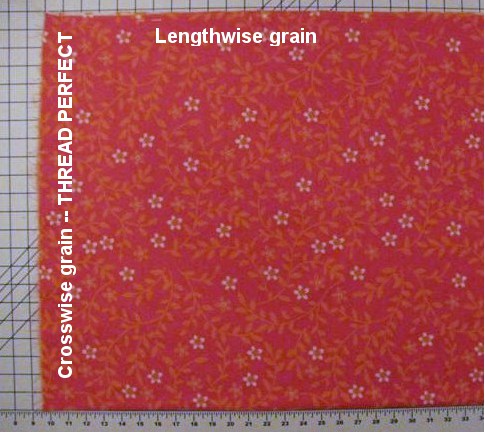As any experienced sewer knows, laying pattern pieces on woven fabric to the straight of grain is essential so finished garments or sewing projects will hang straight and maintain their shape. For that to happen, the sewer must be certain the fabric is on grain in the first place. The first step to determining that is to make the fabric thread perfect.

Fabric is thread perfect when a single crosswise thread can be pulled from selvage edge to selvage edge.
When the crosswise threads and lengthwise threads that make up the woven cloth run at right angles to each other, the fabric is on grain.
All woven fabrics consist of two sets of yarns, or threads, that form the fabric’s “grain.”
1. The lengthwise yarn, or warp yarn, runs parallel to the finished edge (selvage) of the fabric and forms the lengthwise grain of the fabric. In this direction, the fabric is strongest and will stretch the least. For this reason, most items are generally cut along, or to, the lengthwise grain.
2. The crosswise threads, or weft yarns, are woven in between the warp yarns to create the woven cloth and form the crosswise grain. The crosswise threads run across the fabric from selvage edge to selvage edge. Fabric in this direction has more stretch and is less strong.

There are several methods that can be employed to make fabric thread perfect.
The easiest way is to simply tear the fabric from selvage edge to selvage edge.
This immediately exposes a single crosswise thread that will run across the width of the fabric, which in a flash makes the fabric thread perfect.
To tear the fabric, simply make a small snip into the fabric at the selvage edge approximately 1 inch down from the crosswise edge. With a firm grip, tear the fabric across the crosswise grain. This allows a single thread to be pulled from end to end.

Not all fabrics will tear easily. In fact with some, tearing can distort or rip into the fabric so other methods need to be considered.
One such method is to isolate a single crosswise thread at the selvage and to pull it across the width of the fabric. As the thread is pulled, the fabric will gather and expose a crosswise grainline. Following along this grainline, trim away the excess fabric to make the crosswise edge thread perfect.

When the previous two methods fail, this third method will do the trick. It requires unraveling threads along the crosswise edge, one by one, until a single thread can be pulled across the width of the fabric. This is a slow and tedious process, but for many tightly woven or twill type fabrics, it is the only method that will work.
Regardless of method used, the fabric is thread perfect when a single crosswise thread can be pulled from selvage edge to selvage edge.
Now, lets make sure the fabric is on grain.
To determine that, fold the length of fabric in half matching the selvage edges together. Pin them in place. Then, do the same with the crosswise edges. If the fabric is on grain it should lie perfectly flat along the folded edge. If it does, the fabric is on grain. In other words, the cross and lengthwise threads that run through the fabric are at perfect right angles to one another.

If the fold line ripples, it is off grain. A relatively common situation, there are ways to bring the fabric back on grain. Next week, I’ll share a post on how to do just that.
Tomorrow on the Craftsy blog, we’ll share a tutorial on how to sew your own caftan without a pattern.

Share tips, start a discussion or ask one of our experts or other students a question.
No Responses to “Fabric Grainline: Making Fabric Thread Perfect”